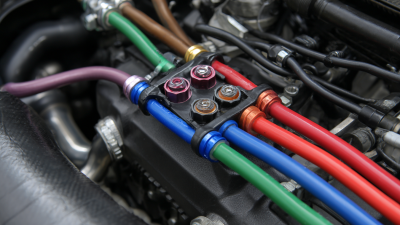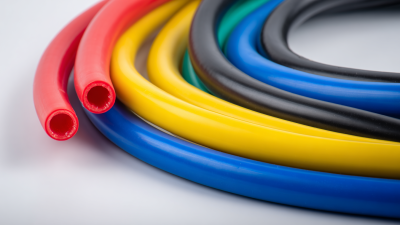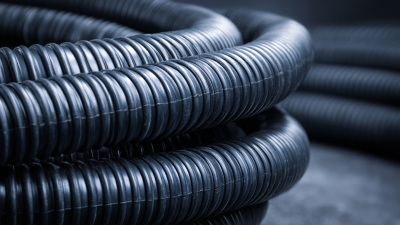The automotive industry is undergoing a transformative phase, with innovative materials playing a crucial role in enhancing vehicle performance and efficiency. Among these materials, the Automotive Silicone Hose has emerged as a key component, offering superior durability and flexibility compared to traditional rubber alternatives. According to a recent report by MarketsandMarkets, the global silicone hose market is projected to reach USD 2.4 billion by 2025, driven by increasing demand for high-performance automotive components. These hoses not only withstand extreme temperatures and pressures, but they also provide better resistance to aging, ensuring longevity in modern vehicle designs.

As manufacturers seek to optimize engine performance and reduce emissions, understanding the innovative uses of Automotive Silicone Hose becomes imperative in shaping the future of vehicle engineering. In this blog, we will explore how these hoses are revolutionizing automotive design and the various applications that make them indispensable in today’s automotive sector.
The modern automotive industry is increasingly recognizing the versatility of automotive silicone hoses, particularly in engine cooling systems. Unlike traditional rubber hoses, silicone hoses boast superior heat resistance and flexibility, allowing them to perform efficiently in high-temperature environments. This makes them an ideal choice for maintaining optimal engine temperatures and enhancing overall performance. Moreover, their ability to withstand extreme pressure and harsh chemicals translates to longer service life and reduced maintenance costs.
Tip: When selecting silicone hoses for your vehicle, consider options that are reinforced with layers of fabric or mesh. This added strength not only helps resist wear and tear but also improves performance under high-pressure conditions.
Another significant advantage of silicone hoses is their wide range of color and style options, which can enhance the aesthetic appeal of engine compartments. Customizing the appearance of these hoses allows car enthusiasts to showcase their vehicle’s personality while benefiting from the high-performance features of silicone material.
Tip: Ensure that you choose silicone hoses that meet the specific temperature and pressure ratings required for your engine cooling system to maximize efficiency and reliability.
Automotive silicone hoses are increasingly recognized for their revolutionary impact on air intake systems, particularly in enhancing vehicle performance. Recent studies in the automotive sector suggest that silicone hoses can withstand temperatures ranging from -50°C to 200°C while providing superior flexibility and durability compared to traditional rubber hoses. This attribute is pivotal for modern vehicles that demand reliable performance under varying environmental conditions. The lightweight nature of silicone hoses contributes to a significant reduction in overall vehicle weight, improving fuel efficiency and responsiveness.
In the realm of high-performance diesel engines, silicone hoses play a vital role in optimizing airflow, which is crucial for enhancing combustion efficiency. A report by industry analysts indicates that vehicles equipped with advanced air intake systems experience up to a 15% increase in horsepower, underscoring the importance of high-quality materials like silicone. Furthermore, the ability of silicone hoses to reduce turbo lag can lead to more immediate throttle response, a critical factor for performance-driven designs. As the automotive industry shifts towards innovation, the integration of silicone hoses is set to redefine performance benchmarks and reliability in vehicle engineering.
This chart illustrates the various performance benefits of automotive silicone hoses in modern vehicle designs. The data reflects the positive impact silicone hoses have on enhancing performance, flexibility, heat resistance, durability, and weight reduction in air intake systems. Each benefit is assessed based on its effectiveness percentage, showcasing the significant role these materials play in revolutionizing automotive engineering.
 The advancement of silicone hose technology has significantly impacted modern vehicle designs, especially in exhaust systems. Silicone hoses are renowned for their remarkable heat resistance, capable of withstanding temperatures exceeding 300 degrees Celsius. This feature is vital in exhaust applications, where high temperatures can compromise the integrity of traditional rubber hoses.
According to a recent industry report, the global silicone hose market is expected to grow by 7% per year, highlighting the increasing adoption of silicone solutions in automotive engineering.
The advancement of silicone hose technology has significantly impacted modern vehicle designs, especially in exhaust systems. Silicone hoses are renowned for their remarkable heat resistance, capable of withstanding temperatures exceeding 300 degrees Celsius. This feature is vital in exhaust applications, where high temperatures can compromise the integrity of traditional rubber hoses.
According to a recent industry report, the global silicone hose market is expected to grow by 7% per year, highlighting the increasing adoption of silicone solutions in automotive engineering.
In addition to heat resistance, silicone hoses offer superior flexibility, allowing for easier installation and routing in complex exhaust layouts. Their ability to withstand vibrations and thermal expansion is crucial for maintaining exhaust efficiency and longevity. A comparative study indicated that vehicles utilizing silicone hoses experienced a reduction in exhaust back pressure by up to 10%, enhancing overall engine performance.
Tips: When selecting silicone hoses for your vehicle's exhaust system, ensure that you choose products with high-quality silicone and proper reinforcement to withstand specific temperature and pressure requirements. Regularly inspect the hoses for any signs of wear or damage, as failure to do so can lead to costly repairs. Lastly, consider consulting with industry experts to identify the best silicone hose solutions tailored to your vehicle’s unique performance needs.
In the evolving landscape of modern vehicle designs, silicone hoses are making significant strides, particularly in the realms of hydraulics and fuel systems. As detailed in recent reports, the industrial hose industry is projected to reach a valuation of $13.92 billion by 2030, indicating a growing demand for innovative solutions in fluid transfer applications. Silicone hoses, known for their flexibility and resistance to extreme temperatures, are ideally suited for high-performance hydraulic systems that require efficient and reliable fluid conveyance.

The advancements in fluid conveyance systems are not only optimizing fluid transport but also enhancing the overall efficiency of modern vehicles. As highlighted in industry trends, the market for fluid conveyance systems is set to experience substantial growth between 2025 and 2035. The adoption of silicone hoses in fuel systems showcases their ability to withstand aggressive fuel compositions while maintaining integrity and preventing leaks. This adaptability positions silicone hoses as a key component in promoting safety and performance in contemporary automotive engineering, ultimately aligning with the industry's shift towards more sustainable and efficient vehicle designs.
The shift towards sustainable automotive design has brought forth a myriad of innovative materials, with silicone hoses emerging as a front-runner in promoting environmental benefits. Unlike traditional rubber hoses, silicone hoses are crafted from synthetic materials that offer exceptional durability and resistance to extreme temperatures, making them suitable for a range of automotive applications. This longevity means that vehicles can feature silicone hoses that last significantly longer, reducing the frequency of replacements and, consequently, waste generation.
Moreover, silicone hoses are not only beneficial for the environment due to their lifespan but also their energy efficiency. These hoses facilitate better airflow and fluid transfer, optimizing engine performance and increasing fuel efficiency. By improving the overall efficiency of modern vehicles, silicone hoses contribute to lower carbon emissions, aligning with the global push for greener technologies. As automotive designers incorporate silicone hoses into their innovations, they underscore the critical role of sustainable materials in modern vehicle design, ultimately working towards a more eco-friendly future in the automotive industry.






